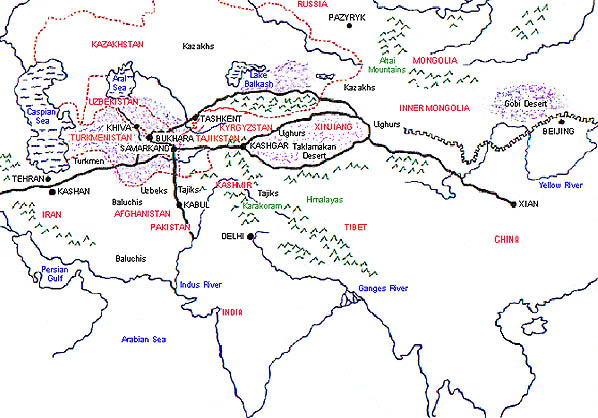|
The
early stages
The history of Central Asia is long, complex and tumultuous.
It is a history of movement, the movement of ideas, people,
commodities, political power and national borders. In its
early stages, Central Asian history was largely determined
by successive incoming waves of nomads from the north-east,
who proceeded to displace the settled inhabitants of the
area forcibly. This process was repeated over the centuries
and highlighted the differences between the nomadic and
urban ways of life; it also highlighted the interdependence
of each group with the other.
Influence
of other cultures
Over many centuries the surrounding eastern and western
cultures — China, Europe, India and Persia — exchanged
their goods and ideas via the Silk Road, which passed through
the middle of Central Asia. This cultural exchange impacted
on the arts and crafts of Central Asia, but in turn the
materials and techniques of this vast region were transferred
to neighbouring cultures.
More
recent history
During the 18th, 19th and 20th centuries, Tsarist Russia
and later the Union of Soviet Socialist Republics (USSR)
strongly influenced the lives of the people of Central Asia,
resulting in a breakdown of the nomadic way of life. With
the demise of the USSR in recent years, the individual republics
are re-evaluating their traditions and celebrating both
their colourful history and the traditional lifestyle and
crafts of both nomads and oasis dwellers.
Activity
Study Fig. 1 Map of the Silk Road to get your bearings.

Fig. 1 Map of the Silk Road
To
explore the main events and the significant textile developments
of this extensive history it is useful to use a timeline.
Read the timeline. Pay particular attention to the dates
with a textile significance. As you work through aspects
of this case study you can refer to the timeline and map
to see where events fit historically and geographically.
The
Silk Road
Network of trade routes
Central Asia is framed by the major cultural centres of
India, China, Iran (Persia) and Europe, which were linked
in antiquity by the great network of trade routes now known
as the Silk Road. The oasis cities along the Silk Road were
the trading posts along the way where traders exchanged
their goods. This allowed the movement and transfer of an
extraordinary range of commodities, together with ideas,
science and technology as well as textile arts, between
these major cultural centres.
 Photo:
Adrienne Cobby
Photo:
Adrienne Cobby |
The
Silk Road opens
The route from China to the west was opened around 200 BC,
but the golden age of the Silk Road was not until around
600 AD, which coincided with the Tang dynasty in China.
During 1200 AD there was a resurgence of the Silk Road trade.
This was shortlived, because of the ravages of Ghengis Khan
and Timur the Great, the development of maritime trade routes,
and the increasing desertification of eastern Central Asia,
which had made travel by caravan more and more perilous.
The
end of the Silk Road
With the establishment of the Ming dynasty in China came
the end of the silk trade along the Silk Road. However,
the interchange between oasis towns along the Silk Road
has continued to some extent.
The
Karakoram Highway
Today's equivalent of the Silk Road is the Karakoram Highway,
which was built by China and Pakistan and runs from Islamabad
to Kashgar. The main difference, however, is that instead
of camels carrying bales of silk the traffic consists of
trucks carrying oil.
Geography
The geography of Central Asia features a vast plain spreading
from the Pacific Ocean Siberia to central Europe. The plain
is divided by mountain ranges fringed by tundra (treeless
plains) and desert. The mountainous areas are rich and fertile.
The oasis cities, towns and villages of this fertile zone
provide the support network for the Silk Road and, in particular,
a reliable supply of water. To the north of the fertile
region the land becomes increasingly arid. This land was
unsuited to farming but ideal for a nomadic lifestyle. Take
a look at Fig. 1 to see this vast region.
 Photo:
Julie King
Photo:
Julie King |
|